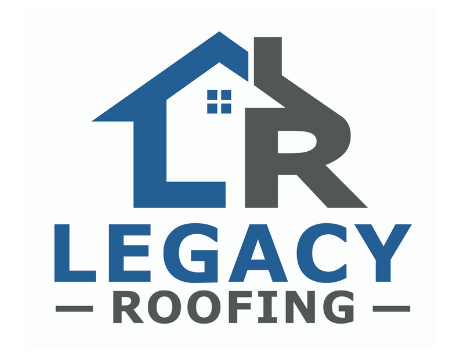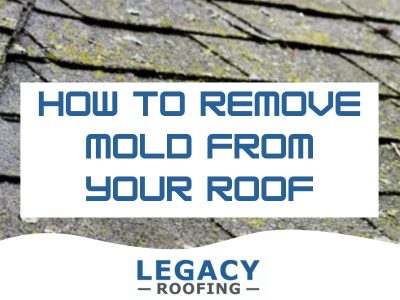Are you trying to learn how to remove mold from your roof?
Whether you have a section or your entire roof covered in mold, you want to have your roof cleaned to remove all organic buildup. Believe it or not, mold can damage your roof and the integrity of your shingles. In today’s article, Legacy Roofing Idaho will teach you how to remove mold and clean your roof – or find someone who can!
First, what is roof mold and what are the risks?
Roof mold sounds terrible, right?
While it is not as common in the Treasure Valley since we have drier areas, roof mold can grow on shingles. The typical signs of mold growth include black streaks, green patches, and even musty odors. It might seem logical to think roof mold is just an ugly fungus. However, the risks of excessive mold growth include damage to your roof shingles, potential health issues, and reduced property value.
Over time, excessive mold growth can lead to roof leaks, structural damage, and lead to roof replacements. The most common types of mold that grow on roofs include Gloeocapsa magma and other algae species. Factors that lead to mold growth often include:
- high humidity,
- poor ventilation and
- debris accumulation (leaves sitting on the roof or water in gutters).
Now that are aware of the associated risks of prolonged mold growth on your roof, let’s explore the steps to get rid of it!
3 Steps to Remove Mold from Your Roof:
Before you try to clean your own roof, please consider the following. Cleaning your home’s roof is a large project and you can save time and even money if you let a professional home washing company clean it for you. There are associated risks with climbing ladders, getting on your roof, and trying to cover mold-covered shingles alone. Most of the cleaning process is done with chemicals; you should never power wash your asphalt shingles. Now, if you insist on cleaning your roof by yourself or want to learn the process simply, here are the steps:
1. Preparing for Mold Removal
First, it is important to start with getting all the things you will need to clean your roof, including items like protective gear, the right cleaning solutions, and ladders.
- Protective gear: Thick rubber gloves, a breathing mask, slip-resistant work boots, and goggles to prevent exposure to mold spores and cleaning chemicals.
- Cleaning solution: Choose the right cleaning solution, such as a bleach solution or a bleach-free alternative, depending on the type of roof shingles and the severity of mold growth. You want to complete research on your shingles, but most cleaning products are a chlorine bleach solution.
- Get your cleaning supplies: A pump sprayer, garden hose, and soft-bristled brush to remove mold without damaging the roof.
- Protect your house & landscaping: Covering plants and surfaces to prevent damage from cleaning chemicals and debris.
Once again, consider hiring a professional power washing company that specializes in roof cleaning if you’re not comfortable with heights or unsure about the best removal methods. You have to consider many factors just to get to the point of the initial cleaning.
2. Cleaning and Removing Mold
After you gather your supplies, the cleaning process is pretty simple. Aside from spraying solutions and water, you shouldn’t have to do much scrubbing unless there is a serious mold problem in a particular area.
- Step 1: Use a pump sprayer to apply the cleaning solution to the moldy roof shingles. Simply mist the areas or the entire roof.
- Step 2: If there are very thick areas of mold, you can lightly scrub the moldy areas with a soft-bristled brush to loosen stuck-on mold and debris.
- Step 3: Rinse the roof thoroughly with a garden hose to remove the cleaning solution and debris.
Remember never to use a pressure washer, which can damage roof shingles and strip away protective coatings. You might have to repeat the cleaning process again to ensure complete mold removal.
3. Preventing Regrowth and Reinfestation
Mold usually grows with little sun exposure and in damp areas. That is why you will see algae and mold on one side of a house, for example. It is usually the side with the least sun exposure.
To prevent mold growth on your roof after cleaning it, you can:
- Install copper or zinc strips along the top ridge of the roof to prevent regrowth and reinfestation.
- Trim trees and shrubs to reduce shade and debris accumulation, which can contribute to mold growth.
- Improve ventilation and airflow around the roof to reduce moisture accumulation and prevent mold growth.
- Regularly inspect and clean the roof to prevent debris accumulation and mold growth.
Long-Term Roof Maintenance Tips

We commend you for wanting to learn more about your roof and how to keep it clean. Part of roof maintenance includes regular inspections, cleaning mold, and monitoring after storms.
If you want to avoid permanent damage to your roof, be sure always to have our roof inspected every few years by a roofing contractor like Legacy Roofing of Idaho! Older roofs will require more TLC as their age and regular maintenance can prolong their lifespan; however, if you constantly have to clean or repair your roof, this could mean you need new shingles!
Key Takeaways:
- Clean your roof with a chemical solution using a “Soft Wash” method.
- Moss, algae, mold, and organic build-up can cause damage to your shingles, so be sure to have your roof cleaned.
- Consider hiring a professional roof cleaning company to remove algae and mold growth.
FAQ:
1. Why is it important to remove moss from my roof?
Moss can damage roofing materials over time by trapping moisture against the surface, leading to rot, shingle deterioration, and leaks. By regularly removing moss, you extend the life of your roof, reduce the risk of costly repairs, and maintain a cleaner appearance.
2. What are the safest methods to remove moss from my roof?
There are several effective and safe ways to remove moss, including using a gentle brush to sweep it off, applying a moss-removal solution designed for roofs, or using a low-pressure power washer. Avoid harsh chemicals or high-pressure washing, as these can damage shingles and cause water to seep.
3. How can I prevent moss from growing on my roof in the future?
To prevent moss from returning, consider trimming overhanging branches to reduce shade, improving roof ventilation, and installing zinc or copper strips along the ridge, which release elements that deter moss growth when it rains. Regularly clearing leaves and debris can also help prevent a build-up of algae growth and moss-friendly moisture.



 Christmas Lights: The Best Holiday Outdoor Light Hanging Tips
Christmas Lights: The Best Holiday Outdoor Light Hanging Tips